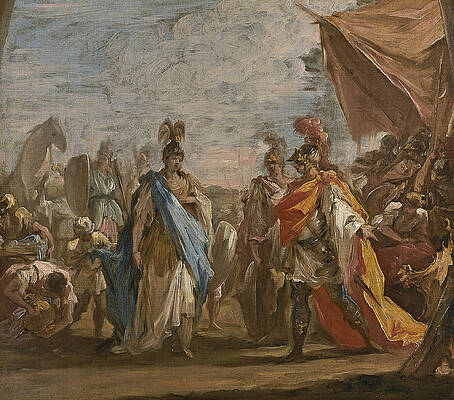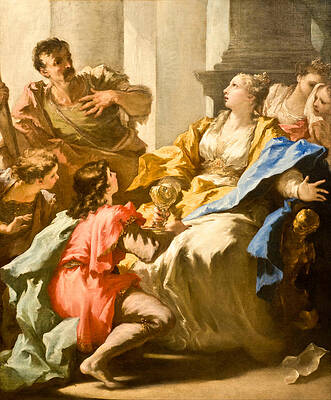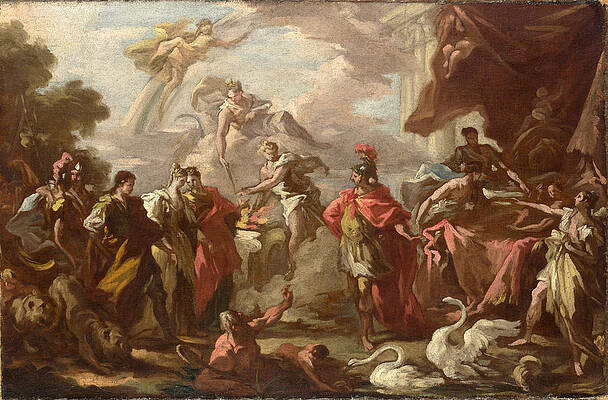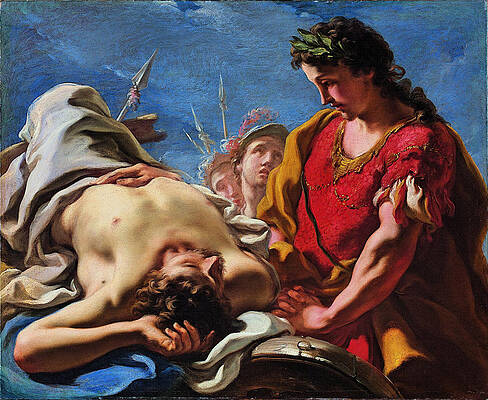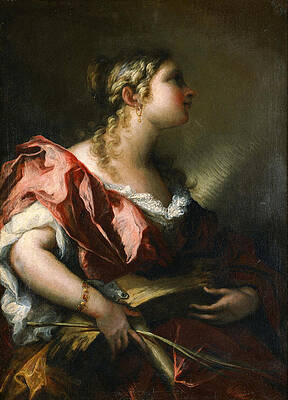Giovanni Antonio Pellegrini
Paintings
Alexander the Great and Thalestris, Queen of the Amazons
Sophonisba Receiving the Cup of Poison
An Allegory of the Marriage of the Elector Palatine
Rebecca at the Well
Apotheosis of a Marine Commander
Alexander at the Corpse of the Dead Darius
Saint Catherine of Alexandria
Erminia and the Shepherds
Young Hannibal swears enmity to Rome
Bacchus and Ariadne
Diana and Endymion

An Allegory of the Marriage of the Elector Palatine

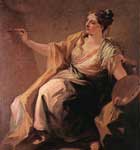
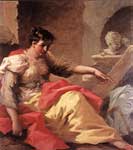
Fine Art Prints | Greeting Cards | Phone Cases | Lifestyle | Face Masks | Men's , Women' Apparel | Home Decor | jigsaw puzzles | Notebooks | Tapestries | ...
Alexander at the Corpse of the Dead Darius
Giovanni Antonio Pellegrini (29 April 1675 – 2 November 1741) was a widely travelled Rococo decorative painter from Venice, where he was born and died. He is considered to be one of the most important Venetian painters of the early 18th century, melding the Renaissance style of Paolo Veronese with the Baroque of Pietro da Cortona and Luca Giordano,[1] and is considered an important predecessor of Giovanni Battista Tiepolo. One of his pupils was Antonio Visentini.[2]
Life
Pellegrini's father, also called Antonio, was a shoemaker from Padua. Pellegrini was a pupil of Paolo Pagani and of Sebastiano Ricci. He married Angela Carriera, the sister of Rosalba Carriera, in c.1704. Pellegrini decorated the dome above the staircase at the Scuola Grande di San Rocco in 1709.
He is mainly known for his work in England, which he visited from 1708 to 1713 at the invitation of the Earl of Manchester, and where he had considerable success. He painted murals in a number of English country houses, including at Kimbolton Castle for the Earl of Manchester, Castle Howard (where his work was mostly destroyed in 1940), and Narford Hall, Norfolk, for Sir Andrew Fontaine.[3] Michael Levey, describing Pellegrini's paintings on the staircase at Kimbolton, says that, although painted directly into the wall in oil, "they have all the spontaneity and lightness of fresco.[4] In London he worked at 31 St James's Square for the Duke of Portland, where George Vertue noted in his notebooks "the hall and Staircase and one or two of the great rooms".[5]
He became a director of Sir Godfrey Kneller's Academy in London in 1711. He submitted designs for the decorating the interior dome of the new St Paul's Cathedral, and is said to have been Christopher Wren's favourite painter, but did not win the commission, losing out to Sir James Thornhill.
Pellegrini then travelled through Germany and the Netherlands, collecting Northern paintings as he went[6] and completing works in many European cities. In 1713-4 he was in Düsseldorf, where he painted a series of allegorical scenes of the life of the elector, Johann Wilhelm.[7] He decorated the Golden Room in the Mauritshuis in The Hague, and carried out other decorative schemes in Prague, Dresden and Vienna. He returned to England in 1719, but was less successful on his second visit, mainly due to competition from other Venetian painters, including his former teacher Sebastiano Ricci.
In about 1720[8] he painted the ceiling of John Law's Bank of France in Paris (since destroyed),[9] Pellegrini also painted a Bellona and Justice Fulminating Vices now held by the Blanton Art Museum in Austin, Texas.
References
"In the Venetian paintings of Giovanni Antonio Pellegrini (1675-1741), Giordano's flamboyant theatricality is made decorative and reduced in scale", observes E.J. Olszewski of his Continence of Scipio (Olszewski, "A Rediscovered Holy Family by Francesco Trevisani" The Bulletin of the Cleveland Museum of Art, 1977.
R. Pallucchini, La pittura veneziana del Settecento, 1960; P. Zampetti, Dal Ricci al Tiepolo, 1969; G. Knox, Antonio Pellegrini, 1675-1741 (Oxford University Press), 1995.
G. Knox, "Antonio Pellegrini and Marco Ricci at Burlington House and Narford Hall", The Burlington Magazine, 1988.
Levey 1980, p.50
"St. James's Square: No 31: Norfolk House". Survey of London: volumes 29 and 30: St James Westminster, Part 1. 1960. pp. 187–202. Retrieved 21 June 2006.
Some of the Flemish and Dutch paintings passed to Consul Smith and were sold to George III. Frances Vivian, "Joseph Smith and Giovanni Antonio Pellegrini", The Burlington Magazine 104 No. 713 (August 1962:330-33.
Levey 1980, p.50
Levey 1980, p.50
C. Garas, "Le plafond de la Banque Royale de Giovanni Antonio Pellegrini", Bulletin du Musée Hongrois des Beaux-Arts, 1962.
References
Levey, Michael (1980). Painting in Eighteenth Century Venice (second ed.). Oxford: Phaidon.
Artcyclopedia
Biography from the Web Gallery of Art
Biography
Further reading
Edward Croft-Murray, Decorative Painting in England 1530-1837, 2 vols. London 1962, 1971.
----
Fine Art Prints | Greeting Cards | Phone Cases | Lifestyle | Face Masks | Men's , Women' Apparel | Home Decor | jigsaw puzzles | Notebooks | Tapestries | ...
----
Artist
A - B - C - D - E - F - G - H - I - J - K - L - M -
N - O - P - Q - R - S - T - U - V - W - X - Y - Z
Retrieved from "http://en.wikipedia.org/"
All text is available under the terms of the GNU Free Documentation License


